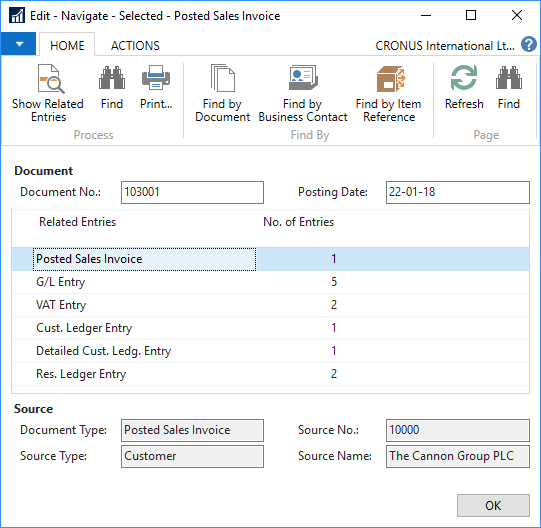Navigate is an underappreciated tool for both the user and the developer. Our focus here is on its value to the developer. Navigate (Page 344) finds and displays the counts and types of all the associated entries for a particular posting transaction. The term associated, in this case, is defined as those entries having the same Document Number and Posting Date. This is a handy tool for the developer as it can show the results of posting activity and provide the tools to drill into the detail of all those results. If we add new transactions and ledgers as part of an enhancement, our Navigate function should be enhanced to cover them too.
Navigate can be called from the Navigate action, which appears in a number of places in the Departments Tasks menu and Role Center ribbons. From anywhere within NAV, the easiest way to find Navigate is to type the word into the Search box (see the next screenshot):

If we invoke the Navigate page using the menu action item, we must enter the PostingDate and DocumentNumber for the entries we wish to find. Alternately, we can enter a Business Contact Type (Vendor or Customer), a Business Contact No. (Vendor No. or Customer No.) and, optionally, an External Document No. There are occasions when this option is useful, but the PostingDate + DocumentNo. option is more frequently useful.
Instead of seeking out a Navigate page and entering the critical data fields, it is much easier to call Navigate from a Navigate action on a page showing data. In this case, we can just highlight a record and click on Navigate to search for all the related entries. In the following example, a Posted Invoice is highlighted:

After clicking the Navigate action, the page will pop up filled in, as shown in the following screenshot:

Had we accessed the Navigate page through one of the menu entries we found through Search (Ctrl + F3), we would have filled in the DocumentNo. and PostingDate fields and clicked on Find. As we can see here, the Navigate page shows a list of related, posted entries (one of which will include the entry we highlighted when we invoked the Navigate function). If we highlight one of the lines in the Related Entries list, then click on the Show Related Entries icon at the top of the page; we will see an appropriately formatted display of the chosen entries.
If we highlight the G/L Entry table entries and click on Show, we will see a result like the following screenshot. Note that all the G/L Entry are displayed for the same Posting Date and Document No., matching those specified at the top of the Navigate page:

